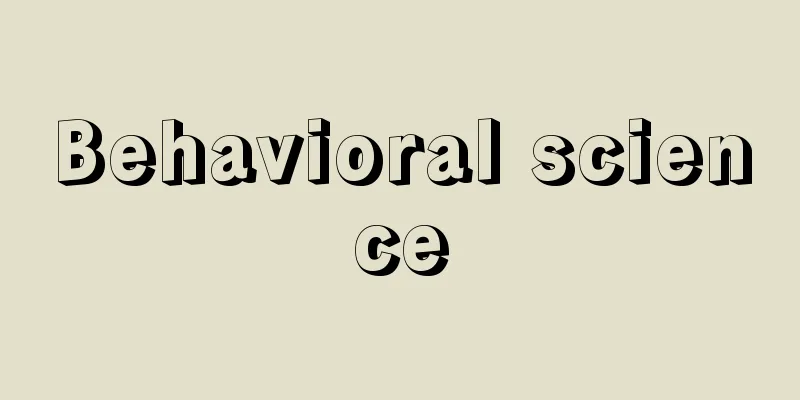Behavioral science

|
A general term for the scientific trend that seeks to (1) grasp human behavior comprehensively, (2) observe, record, and analyze it using rigorous scientific methods, (3) increase predictability by clarifying its laws, and (4) develop technology for planned control and management of society. This trend emerged in the United States around 1950, with anthropology, psychology, and sociology at its core, and has since had a strong impact on fields that deal with human behavior, such as political science, economics, law, and linguistics. Its characteristics can be summarized as the "integration," "rigor," "interdisciplinary" nature of research, and an "applied science orientation." [Oshio Shunsuke] Historical backgroundNeedless to say, the awareness of the problem of studying humans or human behavior in a broad sense can be seen in the theories of anthropology, psychology, sociology, and other fields that were developed in 19th century Europe. The seeds of today's behavioral science were already present there. However, when the European, rather speculative ideas were transplanted to the soil of American scientific culture (empiricism and pragmatism), they were replaced by hypotheses based on systematic data collection, which were thought to be useful knowledge for solving problems. On the one hand, this trend created a tendency for research fields and research themes to become specialized or fragmented (the number of presentation sections at academic conferences has increased rapidly), but at the same time, it also encouraged increased cooperation and integration between disciplines. For example, linguistics was linked to fields such as semiotics, logic, and communication theory, and research on the structure and function of power and authority became important research topics not only in political science but also in social psychology, sociology, and anthropology. The development of political psychology, political sociology, economic psychology, economic anthropology, sociology of law, social psychiatry, human ecology, and other fields are new fields that fill the gaps between academic disciplines and have shown a trend toward the integration of sciences, as the seeds of today's interdisciplinary research. The studies on "culture and personality" conducted by American cultural anthropologists after World War II were a good example of this trend. This research was the result of interaction with psychiatry, psychology, and sociology, and from this trend emerged a position that advocated the establishment of anthropology, or human science, which would integrate these sciences and study the relationship between human behavior and cultural conditions. It was also argued that this research subject had important practical significance in promoting mutual understanding between people of different cultures. The above trends eventually became the background to the claims of behavioral science. [Oshio Shunsuke] The formation of behavioral scienceThe term "behavioral science" was first used in the late 1940s by a group of scientists at the University of Chicago led by psychologist James G. Miller. In his paper "Toward a General Theory of Behavioral Science," Miller argued that in order to promote rigorous scientific research into human behavior, a comprehensive research system that encompasses biological science to social science was necessary, and he listed 18 fields of study that this would include: anthropology, biochemistry, ecology, economics, genetics, geography, history, linguistics, mathematics, neurology, pharmacology, physiology, political science, psychiatry, psychology, sociology, statistics, and zoology. However, his argument was motivated in part by a political science movement to obtain large-scale project research grants from the National Science Foundation, which was established in 1950, from non-natural science departments. Therefore, its definition was somewhat ambiguous. The term "behavioral science" became more commonly used after the Ford Foundation provided large amounts of research grants to this field through its Behavior Science Program in the 1950s. Bernard Reuben Berelson, the project's director, in his "Behavioral Science Series" on the Voice of America (VOA) Broadcasting University, defined the scope of behavioral science quite clearly as anthropology, psychology, and sociology, excluding archaeology, physical anthropology, and visual and auditory psychology, plus political science, law, psychiatry, geography, biology, economics, and history that are interested in human behavior. The name behavioral science has since spread rapidly and has had a widespread impact on the fields it relates to. [Oshio Shunsuke] ExpandBehavioral science, which aims to introduce the methods of rigorous science into behavioral research, was initially led by psychologists with a tradition of behaviorist psychology. Sociology and cultural anthropology, which already had a large amount of accumulated data on behavior, soon joined in. Political science, which has dealt with philosophical, historical, and institutional themes, was a little late, and was shocked by what was called the "behavioral science revolution." The influence of behavioral science also spread to parts of the fields of law, economics, and linguistics. Research topics also became more diverse, and active analysis of the behavior of organizations and management systems, public opinion, trends, political socialization, voting behavior, the process of policy and legislation formation, the decision-making process in courts, language behavior, consumer behavior, and even power relations and conflicts in the international political system were all analyzed. Rensis Likert's "Behavioral Science of Management" (Japanese translation 1964) and "Behavioral Science of Organizations" (Japanese translation 1968), and George Katona's "Consumer Behavior" (Japanese translation 1964) are some of these works. The first important issue that contributed to the development of behavioral science was the development of methodological and theoretical models for observation. Group dynamics (Lewin), category systems of interaction (Robert Freed Bales), exchange theory (Homans), action systems and social systems models (T. Parsons), etc. made a great contribution to the theoretical framework and observational methodology of behavioral research. Secondly, there is the introduction of statistical methods and mathematical models for data analysis, such as sampling methods, statistical analysis and testing methods, game theory, general systems theory, cybernetics, operations research, and simulation. Thirdly, large, high-performance computers were rapidly developed, making it possible to process large amounts of data at high speed. Fourth, data banks and data libraries, facilities for collecting, storing, and sharing large amounts of quantitative data, began to be established at major universities from the 1960s. Fifth, new systems that make interdisciplinary behavioral research possible have been established in university teaching and research institutions, such as the Department of Social Relations at Harvard University, the Human Relations Institute at Yale University, and the Center for Human Development at the University of Chicago. Sixth, the publication of specialized journals. Results are being published one after another in journals such as Behavioral Science (first published in 1956) and The Journal of Conflict Resolution (first published in 1957). [Oshio Shunsuke] Current situation and issuesThe social engineering orientation of behavioral science (prediction and control) has gradually shifted its focus to environmental, urban, and international political issues, and large-scale project research is becoming more and more common. At the same time, terms such as environmental science, policy science, and management science, which emphasize interdisciplinary collaborative research, are tending to replace "behavioral science," which is losing its initial enthusiasm for a unified science. In the field of political science in particular, behavioral science has been criticized for not yet having matured in its applied scientific utility, and for only producing trivial hypotheses at great expense. This criticism also involves issues of value, but nevertheless, this research trend is expected to continue in the future. [Oshio Shunsuke] "Introduction to Behavioral Science" by B. Berelson et al., translated by Tetsuro Sasaki (1962, Seishin Shobo) " ▽ "Behavioral Science" by B. Berelson and G.A. Steiner, translated by Mitsuru Inuda (1968, Seishin Shobo)" ▽ "Encyclopedia of Behavioral Science" edited by B. Berelson and G.A. Steiner, translated by Hiroshi Minami and the Social Behavior Research Group (1966, Seishin Shobo)" [Reference items] | | |Source: Shogakukan Encyclopedia Nipponica About Encyclopedia Nipponica Information | Legend |
|
人間行動を、(1)総合的にとらえ、(2)厳密な科学的手法によって観察・記録・分析し、(3)その法則性を明らかにすることによって予測可能性を高め、(4)社会の計画的な制御や管理のための技術を開発しようとする、科学の動向を総称する。この動向は、人類学、心理学、社会学を中核として、1950年ごろにアメリカでおこり、その後、政治学、経済学、法律学、言語学などのうち、人間行動を扱う分野にも強い影響を与えた。その特徴を要約すれば、研究の「総合化」「厳密化」「学際化」「応用科学的志向」などの点をあげることができる。 [大塩俊介] 歴史的背景広義に人間、あるいは人間行動の研究を目ざそうとする問題意識は、いうまでもなく19世紀ヨーロッパに展開された人類学、心理学、社会学などの諸理論のうちにみることができる。今日の行動科学の芽はすでにそのなかに存在していた。しかしヨーロッパの、どちらかといえば思弁的観念は、アメリカの科学的文化の土壌(経験主義と実用主義)に移植されると、組織的なデータの収集に基づく諸仮説という形に置き換えられ、またそれは問題解決に役だつ知見であるはずだ、と考えられるようになった。この動向は、一方で研究分野や研究主題の分化・専門化、あるいは断片化という傾向(学会の発表部門数の急速な増加)を生むと同時に、学問間の協力の増大、総合化を促すことになる。たとえば、言語学は記号論、論理学、コミュニケーション論などの分野と結び付き、権力や権威の構造・作用に関する研究は、政治学以外でも、社会心理学、社会学、人類学の重要な研究主題となった。政治心理学や政治社会学、経済心理学や経済人類学、法社会学、社会精神医学、人間生態学などの発展は、モザイク的な学問間の溝を埋める新しい分野であり、今日の学際的研究の萌芽(ほうが)として、諸科学の統合という傾向を示してきた。 第二次世界大戦後、アメリカの文化人類学者たちによって行われた「文化とパーソナリティー」に関する諸研究は、とくにこの傾向を示す好例であった。この研究は精神医学、心理学、社会学との交流の成果であったが、この流れのなかから、これら諸科学を統合して人間行動と文化の諸条件との関連を研究する、人間学、あるいは人間科学の確立を主張する立場も現れた。またこの研究主題は、異文化間の人間相互の理解を進めるうえで重要な実用的意義をもつと主張された。 以上の動向は、やがて行動科学の主張を生む背景となっている。 [大塩俊介] 行動科学の形成「行動科学」ということばは、1940年代の末に心理学者ミラーJames G. Millerを中心としたシカゴ大学の科学者グループによって使われ始めた。ミラーは「行動科学の一般理論に向けて」と題する論文のなかで、人間行動の厳密な科学的研究を推進するためには、生物科学から社会科学を網羅した総合的な研究態勢が必要であるとし、これに含まれる学問として、人類学、生化学、生態学、経済学、遺伝学、地理学、歴史学、言語学、数学、神経病学、薬学、生理学、政治学、精神医学、心理学、社会学、統計学、動物学の18領域をあげている。しかし彼の主張の動機には、1950年に創設された国立科学財団National Science Foundationに非自然科学部門からも大規模プロジェクト研究の助成費を得るための、政治的な科学運動という一面があった。したがってその定義もややあいまいであった。「行動科学」の名称をむしろ一般化したのは、1950年代にフォード財団が行動科学計画Behavior Science Programによって、この分野に多額の研究助成を行ってからである。同計画の主任であったベレルソンBernard Reuben Berelsonは、アメリカの声(VOA)放送大学の「行動科学シリーズ」のなかで、人類学、心理学、社会学のうち、考古学、形質人類学、視覚や聴覚の心理学を除き、これに政治学、法学、精神医学、地理学、生物学、経済学、歴史学のうち人間行動に関心をもつ領域を加えたもの、とかなり明確に行動科学の範囲を限定した。行動科学の名称はそれ以来急速に広まり関係領域に広範な影響を与えるに至った。 [大塩俊介] 展開厳密科学の方法の行動研究への導入を目ざす行動科学は、まず行動主義心理学の伝統をもつ心理学者が主導した。すでに多くの行動に関するデータの蓄積をもつ社会学や文化人類学もすぐにこれに加わった。哲学的、歴史的、制度論的な主題を扱ってきた政治学は、やや遅れ、「行動科学革命」といわれた衝撃を受けた。法学、経済学、言語学分野の一部にも行動科学の影響が浸透してゆく。研究主題も多彩となり、組織や経営システムの行動分析、世論、流行、政治的社会化、投票行動、政策や立法の形成過程、裁判所における判決の決定過程、言語行動、消費行動、さらには国際政治システムにおける勢力関係や紛争の分析などが盛んに行われた。リッカートRensis Likertの『経営の行動科学』(邦訳1964)や『組織の行動科学』(邦訳1968)、カトーナGeorge Katonaの『消費者行動』(邦訳1964)などはその一部である。 行動科学の展開に寄与した重要な問題点としては、まず第一に観察のための方法モデルや理論モデルの発展がある。グループ・ダイナミックス(レビン)、相互作用のカテゴリー・システム(ベールズRobert Freed Bales)、交換理論(ホマンズ)、行為システムや社会システム・モデル(T・パーソンズ)などは、行動研究の理論的枠組みや観察の方法論に関して大きな寄与を果たした。 第二にデータの分析に関する統計学的方法や数理モデルの導入がある。標本抽出法、統計学的解析法や検定法、ゲーム理論、一般システム論、サイバネティックス、オペレーションズ・リサーチ、シミュレーション、など。 第三に大型で高性能なコンピュータが急速に開発され、大量のデータを高速で処理することが可能となった。 第四に膨大な数量的データの収集と蓄積、および共同利用のための施設としてのデータバンク、データライブラリーが、1960年代から主要な大学に設立され始めた。 第五に学際的な行動研究を可能にする新しい制度が、大学の教育や研究機関として整備されてきた。ハーバード大学の社会関係学部、エール大学の人間関係研究所、シカゴ大学の人間発達研究センターはその好例である。 第六に専門誌の発刊。『行動科学』Behavioral Science(1956創刊)、『紛争解決ジャーナル』The Journal of Conflict Resolution(1957創刊)などに成果が続々と発表されている。 [大塩俊介] 現状と問題点行動科学の社会工学的志向(予測と制御)は、関心の対象をしだいに環境問題、都市問題、国際政治問題へ向けるようになり、大規模なプロジェクト研究もますます多くなっている。同時に学際的共同研究を強調する環境科学、政策科学、管理科学などの呼称が、当初の統一科学志向の熱気を失いつつある「行動科学」にとってかわる傾向もみられる。とくに政治学の分野では、行動科学は、応用科学的効用もまだ未熟であり、膨大なコストをかけてつまらぬ仮説しか並べていないという批判も行われている。この批判には価値の問題もかかわっているが、それにもかかわらず、この研究動向は今後も進んでゆくと予想される。 [大塩俊介] 『B・ベレルソン他著、佐々木徹郎訳『行動科学入門』(1962・誠信書房)』▽『B・ベレルソン、G・A・スタイナー著、犬田充訳『行動科学』(1968・誠信書房)』▽『B・ベレルソン、G・A・スタイナー編、南博・社会行動研究会訳『行動科学事典』(1966・誠信書房)』 [参照項目] | | |出典 小学館 日本大百科全書(ニッポニカ)日本大百科全書(ニッポニカ)について 情報 | 凡例 |
Recommend
Vascular plants - vascular plants
A group of plants with vascular bundles, also kno...
Kamegaoka ruins - Kamegaoka ruins
This site is located in Kizukuri Tateoka, Tsugaru...
Ceratocystis stenoceras (English name) Ceratocystisstenoceras
…[Tsubaki Keisuke]. . . *Some of the terminology ...
Kavafis, Konstantinos
Born: April 29, 1863 in Alexandria Died: April 29,...
Pinus palustris (English spelling) Pinuspalustris
… [Makoto Nishida]. … *Some of the terminology th...
Ramaria aurea (English spelling)
…[Rokuya Imaseki]. . … *Some of the terminology t...
Cornelius Vanderbilt
American shipping and railroad financier. He bega...
Takayasu disease
Also known as pulseless disease or aortitis syndro...
Ogeta Burial Mounds - Ogeta Burial Mounds
...In Kawado, there are the remains of Seri Castl...
Mountaineer Collection - Sankashu
A collection of poems by Saigyo. Three volumes. T...
Noisy - Noisy
〘Self-Ga 5 (4)〙 (In ancient times it was "saw...
AAC type - AAC type
...Learners follow the instructions of the progra...
Gray light - Gray light
...Also called lime light, gray light lamp, calci...
Bowerbankia caudata (English spelling)
...The resting buds are formed asexually in the s...
Ornithine - Ornithine (English spelling)
An amino acid. A basic amino acid. L-ornithine is...









